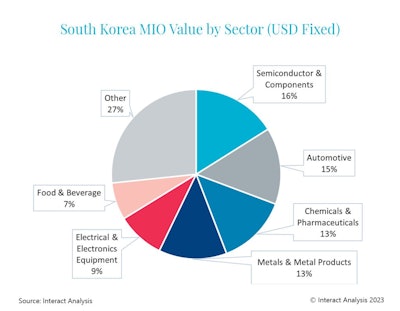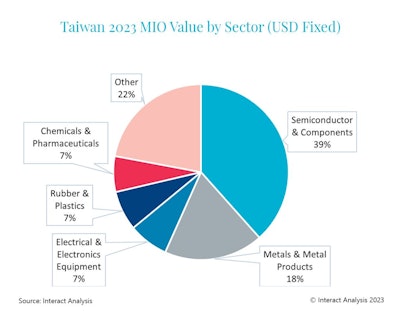
A global slump in demand for consumer electronics is contributing to a worldwide fall in semiconductor orders. This is heavily impacting manufacturing industry output in South Korea and Taiwan, whose economies are hugely dependent on hi-tech products and the semiconductor industry.
The degree of overspecializing in certain Asian markets mean that when things are going really well it’s great. However, markets that are over-reliant on particular products are vulnerable to down-periods and the latest figures from our Manufacturing Industry Output (MIO) Tracker show just how much falling semiconductor demand is affecting South Korea and Taiwan.
Over-reliance on semiconductors to cause 10% shrink in South Korean and Taiwanese economies
Semiconductors form such a huge part of the total performance of South Korea and Taiwan’s manufacturing economies that at Interact Analysis we predict they will see their economies shrink by 10% or more next year.
 South Korea and Taiwan manufacturing output to plummet in 2023 as semiconductor demand dries upInteract Analysis
South Korea and Taiwan manufacturing output to plummet in 2023 as semiconductor demand dries upInteract Analysis
It was inevitable that the semiconductor market would be unable to sustain the levels of growth it has seen in the past couple of years, as supply chain problems coupled with unprecedented levels of orders provided strong conditions for growth.
As we previously predicted, demand has now dropped back, and in some regions has fallen off a cliff. This includes South Korea and Taiwan, which are both facing huge drops in production, according to indicators published by their respective statistics offices.
South Korea’s manufacturing industry has been overperforming during the last couple of years, driven by massive demand for semiconductors, which accounted for over a fifth of the South Korean economy in 2022. However, the market for semiconductors and components is now forecast to shrink by almost 30% and MIO growth for South Korea is subsequently predicted to contract by 9% in 2023.
 The semiconductor & components segment comprises 16% of South Korea’s manufacturing industryInteract Analysis
The semiconductor & components segment comprises 16% of South Korea’s manufacturing industryInteract Analysis
With regards to Taiwan, the country will be the biggest victim of the semiconductor slump, as roughly 40% of manufacturing output is tied to semiconductors and the allied electronics industry. As a result, we predict Taiwanese manufacturing output will shrink this year by nearly 20%, having a substantial impact on the national economy. Following very strong years of growth for semiconductor manufacturing output in 2021 and 2022, South Korea is still not expected to drop below 2019 levels, but Taiwan looks set to fall below this benchmark.
 Taiwan’s manufacturing sector is dominated by the semiconductor & components segmentInteract Analysis
Taiwan’s manufacturing sector is dominated by the semiconductor & components segmentInteract Analysis
The latest analysis and forecast of the industry published by WSTS (World Semiconductor Trade Statistics) in May 2023 saw a substantial downwards revision of its forecast for 2023, from a contraction for 2023 of 4.1% predicted last year, to a 10.3% pull-back. This pattern can also be seen in financial data published by large semiconductor suppliers in both Taiwan and South Korea.
We have lowered our outlook for Asia as a whole, in part because of the slowdown in regions such as South Korea that had been performing above and beyond expectations due to heightened semiconductor demand.
Taiwan’s largest semiconductor manufacturers are suffering
Looking at Taiwan’s largest semiconductor suppliers, TSMC saw its consolidated year-on-year revenue growth for 2023 fall from +65.3% in May 2022 (total annual revenue of ~$48B) to -4.9% in May 2023, while ASE Technology dropped to -14.1% in June 2023 compared with 33.9% in June 2022 (total annual revenue ~$12.5B). TSMC has previously achieved double-digit growth each month for the past two years, with month-on-month highs of up to 60%.
However, AU Optronics appears to be the only large semiconductor in Taiwan to have lost revenue for two years in a row, recording a drop in YoY revenue growth of -20.1% YTD compared to -33.4% for 2022 (total annual revenue ~$10bn). The reasons behind this are unclear, but may be linked to problems AU has had in expanding capacity to compete with other large AMOLED manufacturers and its switch to focus more of its resources on microLED research and development.
What has caused the huge shift in semiconductor production?
Despite plummeting production levels for semiconductors, we are also seeing positive order books in some areas, including North America, Europe and Taiwan. However, other regions have seen orders all but collapse and the impact of the Inflation Reduction Act in the United States is driving up domestic orders and demand rather than improving order books worldwide.
The reasons for plummeting semiconductor production output are complex, with much of the impact attributable to the falling demand for consumer electronics. There are also factors specific to the semiconductor industry, including the need for many chips to be both tailored and available fast. Following the supply chain disruptions and semiconductor shortages of recent years, companies often order from three or four different companies.
This means when the orders come in either the customer or the vendor ends up with a surplus, and these resulting stockpiles have caused a subsequent slowdown in production orders. Semiconductors are also small components that are relatively cheap on an individual unit basis and do not spoil so are easy to store.
There are signs of hope for semiconductors
The semiconductor industry is predicted to bounce back fast, with an uplift in output already anticipated in 2024 when demand and output is expected to pick up. South Korea is now shifting its ambitions towards the emerging market for AI semiconductors and has made no secret of the fact that it sees this as the next segment to boom, with its minister for science and information and communications, Jong-ho Lee, telling CNBC that “South Korea seeks to emerge as a prominent player in rapidly growing and promising areas such as AI semiconductors”.
The government is heavily backing AI, making it part of the nation’s digital strategy and announcing last year it is planning to spend 1.02 trillion won ($786m) on AI semiconductor R&D over five years. Its strong AI base and global dominance of the memory chip market through companies such as Samsung and SK Hynix are likely to help it achieve this goal.
What is a sharp and striking slump in semiconductor demand and in manufacturing output looks set to come to a swift end, but not without leaving a significant mark on the economies of South Korea and Taiwan in particular.






















